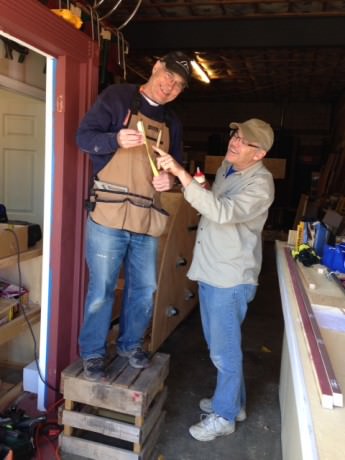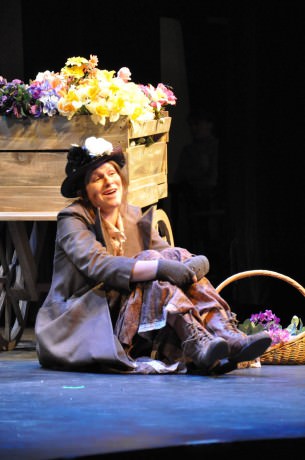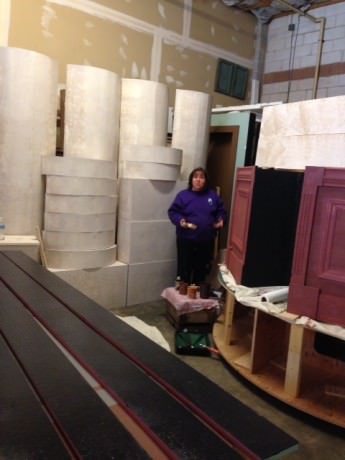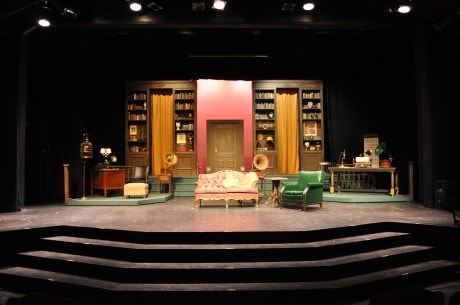Interview with DTC’s My Fair Lady Set Team:
Bill Brown, Set Design
Jim Korte and Bill Rippey, Master Carpenters
Nancy Eynon Lark and Maria Littlefield, Set Dressing & Properties
Joel: Introduce yourself to our readers and tell them where your design was seen in other productions around the DC Metro area. Where did you receive your design training?

Bill Brown: Hi, my name is Bill Brown and I am the overall set designer for this production of My Fair Lady. Mostly I design sets for DTC, with two WATCH nominations for She Loves Me and Meet Me in St. Louis (the latter co-designed with Director Chad Wheeler) but I also design quite a bit for McLean Community Players doing their productions of The Secret Garden and The Drowsy Chaperone among others, and recently started working with Silver Spring Stage designing their production of Superior Donuts. I actually am an architect in my day job, so my design training came from my degree from Catholic University, and my love of theatre.
Jim Korte: I am co-master carpenter, as well as the President of Damascus Theatre Company. I have been involved with building sets for DTC for the past 10 years and this is the most challenging set we have put together. I have always loved working on projects around the house and felt privileged to assist when asked all those years ago to help. There are many added challenges when putting a set together with a constant reminder to yourself (and others on the team) that the set only needs to last 8-10 shows. That being said, we worked long hours on this set (over 550 hours combined) and for only eight shows. We love the team work and results as we coordinate our efforts to pull off an amazing result. My WATCH Nominations include The 25th Annual Putnam County Spelling Bee & Meet Me in St. Louis, both for Outstanding Set Construction in a Musical.
Bill Rippey: I am co-master carpenter and have been involved with DTC for 23 years as an actor, producer, board member, choreographer, musician, and master carpenter. I was nominated for a WATCH Award in 2012 for Meet Me in St. Louis (Outstanding Set Construction in a Musical).
Maria Littlefield: I’m Maria Littlefield, Scenic Painter, Properties, and Set Dressing. I have worked exclusively with Damascus Theatre Company and DTC Kids for eight years. I won a WATCH Award for Little Shop of Horrors (Set Decoration in a Musical), and have been nominated for Meet Me in St. Louis (Set Decoration & Properties in a Musical) and Seussical (Set Painting in a Musical). My “on the job” training came fairly easily as a I took basic design, landscape design, and landscape architecture classes in college, and worked as a product merchandiser for many years and have dabbled in art and crafts.
Nancy Eynon Lark: I have had the pleasure of working with Rockville Little Theatre, Silver Spring Stage, Potomac Theatre Company, and with the new company, Peace Mountain Players at Har Shalom Congregation. This is my second opportunity to work with the wonderfully talented Damascus Theatre Company. As an undergraduate many years ago at the University of Georgia I took a minor in drama and learned some basics of set design, costume design, and props construction. My professional path took me a different direction. Like so many people who are drawn to the theatre I never quite gave up the hope of finding my way back to it. Now that I am retired I have been fortunate to work with directors and set designers who have been both generous with their knowledge of theatre craft and also willing to trust my instincts. I essentially learned the craft by observing and doing. I am also a participant in Round House Theatre’s Heyday Players where our guest teachers are some of the most talented directors and designers in the area.
Why did you want to be part of the design team for this production of My Fair Lady?
Bill Brown: Well, first of all, it’s a fantastic show, one of the first I ever came across when I was introduced to musical theatre in high school. Secondly, I have been working with DTC since 2000, so I was particularly happy to get this call from Director Stephanie Bonte-Lebair and producer Elli Swink.
Maria: Born in 1954, I grew up listening, dancing and dreaming to the songs from this musical in my parents’ living room. Being very partial to period shows, I consider this musical a set dresser’s dream. I consider it a childhood dream fulfilled to have been involved in the creation of this set.
Nancy: I am drawn to period pieces that allow me to “travel” to the late-1800’s/early 1900’s. Design concepts from that golden age in everything from advertising art to furniture to automobiles retain their appeal and influence a century later. My Fair Lady is set in 1912, a year that held so much promise and so much tragedy. The classic story is very much a part of our culture; the songs are old friends even to those few individuals who have never seen the musical or the movie. Working on this production was an opportunity not to be missed. I was also happy for the chance to work once again with DTC where I was part of the design team for She Loves Me in 2010, winning a WATCH Award (Set Decoration in a Musical).

How did your design change since the first meeting with your director?
Bill Brown: Honestly, it hasn’t too much. The things that have changed are the little details. Things got clarified or adjusted based on the construction requirements, “real world” function and budget, but the overall concept and execution are pretty much the same as they were from my original sketches. The concept was for a large central piece that could be the focus of the design and then depending on what budget and time was left, the rest of the details could be built out from there. One of the challenges for Community Theatre is that often you see the moments where the company obviously ran out of money or time. I wanted to design something that could be as grand as possible, but could also be scaled down when and where it was needed and not distract.
Maria: As always, there have been changes to the specifics of the set paint since the first production meeting with director and set designer. I had thought a mahogany finish would be appropriate for Higgins Study, but as the painting process began I realized there is no more difficult wood faux finish to paint than mahogany and was not pleased with my efforts. As things progressed, I began to go in the darker walnut direction and with the base of all the colors used in the mahogany effort, the end product was a rich colored, aged wood finish that fit the period perfectly. The column colors were planned in the gray family to help to emphasize the class distinction in the market. But quickly changed to warmer hues, which are more flexible, as they also show up in the Hungarian Embassy, Mrs Higgins garden and other scenes.
Bill Rippey: I use CAD to help design the construction details that will faithfully, and safely, render the artistic vision of the designers. I would change the question to “How did the construction design change since the first artistic drawings were received?” The primary mechanical challenges included: building 11 foot tall shelf units that each has an open side for the full height for the curtains to travel in and out, and building two 9 foot diameter revolving “drums” that support the shelves and their 150 pounds each of books. CAD also helped work out more artistic issues like size and height proportions of set pieces, layouts of furniture molding and trim, overall “look” of the set for blocking and placement of smaller set pieces, and even a plan for loading the truck.
Our drum/revolve design went through two major and several minor changes to optimize modularity for moving, use 4×8 stock materials to make a 9 foot diameter circle, locate low friction strips to ensure smooth rotation, and locate bulkheads for strength and accurate dimensions. I sometimes presented two different designs to the team and we refined them to a single approach, or often we just used my initial version and improved it
Nancy: The biggest challenge for me was to reign in the elaborate images I had in my mind so that the execution was feasible within the constraints of the venue and the time needed for scene changes. Fortunately, our team had strong designers with the right mix of skills needed both to envision the artistic possibilities and also stay grounded in practical considerations. If all of the decisions had been left solely to me, the run time would have ended up being five hours due to scene changes!
How does your design help tell the story of My Fair Lady?
Bill Brown: This show is a particularly “realistic” show. Shows like Godspell or Pippin can get away with very “theoretical” designs, but My Fair Lady needs to feel real. The library needs to be grand to show the difference between Higgins’ world and Eliza’s. But the show also travels all over London, so I wanted the set to be versatile, which is why I came up with the two large rotating pieces which could be modified in subtle ways to create the different scenes.
Nancy: Henry Higgins embraces technology in his study of dialects. His home and laboratory are filled with the latest machinery and gadgets of the time to capture the sounds of human speech. I wanted to recreate some of the machinery to help establish his world. The three gramophones are genuine; all of the other items including the Ediphone voice recorder, the voice graphing instrument, and the alcohol burner for the “H” practice scene were handmade especially for this production.
The ballroom scene was an important turning point for Eliza Doolittle. Its design had to reflect the fashion of the day and rise to the elegance of a royal ball a world apart from the grimy streets of Tottenham Court. Bill Brown’s creative set design was perfect for this. Maria Littlefield’s beautiful period floral designs framed the ballroom space. I designed the chandelier to fill the space left between the columns. It took many hours to drape the crystal beading by hand.
What challenges have you faced creating your design in the Historic Theatre at Olney Theatre Center?
Bill Brown: This is a very grand show, and fortunately the Historic Stage is equipped to allow us to show that. The biggest problem is the fact that we were unable to use the fly space. Any community theatre who is fortunate enough to have access to a fly system knows how much of a life, time and budget saver it can be. And if any show called for a fly system, it’s My Fair Lady. The need to transition from a realistic library, to the streets of London, to the racetrack, to the bar, to Higgins’ doorstep, etc, etc, provides a particular challenge if you don’t want your set changes to take 10 minutes each and still have room for the actors to walk around backstage.
Jim: There are a few challenges that we have had to overcome by having shows at the OTC Historic Stage. The main one being that our build shop (or storage shop) is 50 miles west of Olney in Frederick, Maryland. After coordination with our Set Designer (Bill Brown), the magic truly begins up at the scene shop. We have to build everything to be mobile and easily packed into a 24′ moving truck. The set is constructed and painted in our Frederick shop location, then broken down and fit into a moving truck and transported to Olney. We then have to rebuild the set within a two day period so that the cast can use it for their rehearsals during tech week. It is 2-3 months of building. packed into a tiny space. then quickly re-pieced together. It take a lot of coordination and effort to make it all happen, but in the end it is all worth it!!!
Without the use of a fly system, we were able to accommodate this challenge by improvising a set that allows for easier (but still challenging) scene changes throughout the show. The ballroom scene has a large chandelier that would have been perfect for a fly system to quickly bring down, but instead we developed a method of bringing in the chandelier with a set of ‘long pitchforks’ with lights on the ends of the poles that allowed us to carry the beautiful chandelier into the set and hang it 14 feet above the stage floor. A glorious sight when the lights come on!
Another challenge is the tight wing space on either side of the stage. The Historic Stage has Stage Left and a Stage Right wing space but the SR side is accommodated by the 10-member orchestra. That limits all of our scene-changing set pieces to the SL side and the need of having quick on-and-off capabilities for scene changes. Two large 8ft x 8ft trucks (or wagons) were created to hold the majority of Higgins’ Library/Study so that the cast/crew could quickly bring out the set. Incredibly, there are five scenes in this show where this massive scene change was to be brought on. The successful and effortless scene changes add to the magic of this show. It is great to see how quickly they can change the set.

Maria: The biggest challenge in painting this set is that it was not assembled into whole units until we moved into the theater. For each of the bookcases there is a base cabinet, bookcase cabinet shell, 4-5 shelves and what we called the top box to tie the cabinets together. For each of the four columns there were five separate pieces and the back of the bookcase that they are mounted on. All of these individual pieces were painted separately, on different days, knowing that there would be little change possible at the theater due to the 12’ size.
How would you describe Director Stephanie Bonte-Lebair’s vision of this production of My Fair Lady, and how has your design brought this vision to the stage?
Bill Brown: I knew that Stephanie wanted to do a very classic version of the show. This was not going to be a “Post-Apocalyptic re-imagining” of the tale, so it was really just a matter of going to the text and seeing what was needed The classic opening in the film in Covent Garden was particularly inspiring for me. Any good design supports the show and doesn’t upstage it. While I always love compliments on my set, it is always gratifying for me when the show as a whole just gels, which I think it has done in spades here.
Nancy: Stephanie’s vision guided the entire production setting the time and defining the space through her choice of color schemes and the level of detail needed. I met with her early in the process to get a sense of her vision and bounce some ideas around. She trusted the entire design team to bring our best efforts to the production, working collaboratively to support her vision.
Why is My Fair Lady still so popular almost 60 years later after opening on Broadway?
Bill Brown: It’s a classic for a reason. It’s a great musical based on a great play. It’s one of the few musicals where you are just as likely to see its source material performed as you are the musical itself. The score is one of the true greats of classic Broadway. It has interesting characters who have real emotional depth and aren’t just excuses to sing a snappy number. (Which I am not opposed to by the way, I love me a snappy number, but it’s great when you can get both.)
Nancy: Well, of course, everyone enjoys a Cinderella story with an unlikely romantic pairing. More than that, I see My Fair Lady as a timeless story of aspiration and longing for a better life set in an era that defined modern culture. In many ways, the social themes of 1912 are quite similar to what we face now in the early decades of the 21st Century. Rapid developments in technology, a widening economic gap that separates the small wealthy class from the large struggling working class, even the continuing struggles women have regarding reproductive rights and roles in government. Not to mention the wonderful music and lyrics that we have come to love. There is so much that we can relate to in our lives today.

What have you learned as a designer after working on your design for this production?
Bill Brown: Firstly, that no problem is so large that there isn’t a solution. And to draw on previous experience wherever possible. This set is an amalgam of about four other sets I have either worked on, designed or seen. Secondly, is that no matter how well you design something, the people who really build it, and paint it, and dress it make all of the difference. I mentioned above about the design being something that could be grander or simpler where needed, and Jim, Bill, Maria, Nancy and everybody else made it grander than I could have expected.
Maria: The set design team for DTC is extraordinary in terms of Community Theatre. We have worked together on many shows and developed the ability to collaborate with our visions and ideas in construction and paint to create sets beyond most seen at this level.
Nancy: I learned a great deal about managing the size and scope of a design within the allotted space. I also had the chance to develop my skills at fabricating set pieces using whatever materials were on hand to create realistic looking period pieces.

What is your favorite scene and song in the show and why?
Bill Brown: Hardest question ever. Sentimental favorite is “I’m Getting Married in the Morning”. As I mentioned above this was one of my first exposures to musical theatre, and this song was the first one I heard. But it’s hard to beat the wonderfully understated “I’ve Grown Accustomed to Her Face” and “I Could Have Danced All Night” is a showstopper for a reason.
Nancy: Hands down, my favorite scene is where Eliza is introduced to Mrs. Higgins and her friends at the Ascot races. The humor is both poignant and ridiculously hilarious. Cara Bachman as Eliza played the scene beautifully, never letting her character fall into slapstick. My favorite song in this production is “Wouldn’t It Be Loverly.” It captures that sense of longing and hope for something better.
What do you want audiences to take with them after seeing My Fair Lady??
Bill Brown: That classic Broadway is amazing. So often the classics get overshadowed by the evolution of musical theatre, but that this show and this score can and should be loved just as much as Company and Rent and Next to Normal.

Nancy: This is a show that has a lot of appeal for young women and girls. I hope that they take away the realization that finding their own true voice means much more than learning to speak a “proper” dialect. In two very different scenes Eliza finds her voice. First, as she grasps the way to say “The Rain in Spain” and second, after the ball, when she realizes that her humanity has been invisible to Higgins. In that pivotal scene she stands up to his bullying and makes it clear that she is much more than a means to win a wager. George Bernard Shaw had a different ending in mind when he wrote Pygmalion. Whether Eliza returns to 27A Wimpole Street as a companion to Higgins is often open to interpretation. I like to think that whatever her decision is, Eliza makes it with a deeper awareness of her own true self and a clear sense of where she is going.
My Fair Lady ended its run on November 23, 2014 at Damascus Theatre Company performing at Olney Theatre Company’s Historic Stage — 2001 Olney-Sandy Spring Road, in Olney, MD.
LINKS
Meet the Cast of ‘My Fair Lady’ at Damascus Theatre Company–Part 1: Brian Lyons-Burke.
Meet the Cast of ‘My Fair Lady’ at Damascus Theatre Company–Part 2: Director Stephanie Bonte-Lebair.
Meet the Cast of ‘My Fair Lady’ at Damascus Theatre Company–Part 3: Cara Bachman.
Meet the Cast of ‘My Fair Lady’ at Damascus Theatre Company–Part 4: William T. Fleming.





